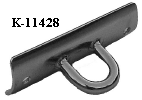mherrcat
Contributing Partner
In rebuilding my boom I have to replace/reinstall the internal boom bails. They are basically a curved metal plate with a 3/16" hole in each end and a small bail welded to the center. (See pic.) Originally held in place with pop rivets.
I was thinking that maybe replacing the rivets with 1/4" machine screws would be stronger. I would enlarge the mounting holes on the plates to 1/4" and weld a nut on the back.
Any thoughts?
I was thinking that maybe replacing the rivets with 1/4" machine screws would be stronger. I would enlarge the mounting holes on the plates to 1/4" and weld a nut on the back.
Any thoughts?

